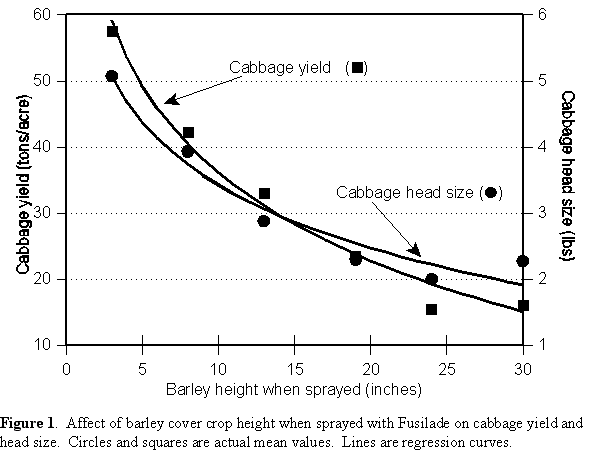
Oakes Irrigation Research
Site
Carrington Research Extension Center * North Dakota State University
P.O. Box 531, Oakes, ND 58474-0531, Voice: (701) 742-2189, FAX: (701)
742-2700, email: rgreenla@ndsuext.nodak.edu
CABBAGE COVER
CROP STUDY
Richard Greenland and Leonard Besemann
Planting a cover crop helps reduce wind erosion and may help conserve soil organic matter and control weeds. If let grow too long it also competes with the cabbage and reduces yield and quality. In this study we investigated how tall we could let a barley cover crop grow before killing it and still not reduce cabbage yield or quality.
MATERIALS AND METHODS
| Soil: | Maddock sandy loam; pH=7.4; 2.2% organic matter; soil-P and soil-K were very high; soil-S was very low. |
| Previous crops: | 1997 - potato; 1996 - field corn; 1995 - carrot and potato. |
| Seedbed preparation: | Disked on 31 October 1997. Multiweeded (field cultivated) twice on April 20 to incorporate herbicide and smooth the seedbed, and once on April 29 to break up the soil crust. |
| Planting: | Direct seeded cabbage on April 29 with a Stanhay vegetable planter modified to drill barley (1 bu/acre, 6-inch rows) between and parallel to the cabbage rows. Cabbage seeds were spaced 7 inches apart in 16-inch rows. Plants were later thinned to 15 inches apart (about 26,000 plants/acre). Seeds were placed ½ to ¾ inch deep into a flat, fine seedbed. |
| Plots: | Each plot was 6 ft wide and 17 ft long. The study had 4 reps. |
| Fertilizer: | On April 13, broadcast 14 lbs N/acre and 70 lbs P2O5/acre as 10-50-0, 16 lbs N/acre and 19 lbs S/acre as 21-0-0-24, and 94 lbs K20/acre as 0-0-60. Applied 70 lbs N/acre as urea on May 29 and sprayed 72 lbs N/acre as 28-0-0 on June 24. |
| Irrigation: | Overhead sprinkler irrigation as needed. |
| Pest Control: | Weeds were controlled using Treflan (1 pt/acre applied preplant incorporated on April 20), Dacthal (10 lbs/acre on May 5), Lentagran (2 lbs/acre on June 11) and by hand weeding. Sprayed Sevin (1.5 pt/acre on May 20) to control flea beetles. Agree (1 lb/acre on June 3 and June 16), Malathion 57 EC (2 pt/acre on July 24), DiPel (1 lb/acre on June 25, July 1, July 7, July 13, July 20, July 27, Aug 11, and Aug 20), and Asana (8 oz/acre on Aug 7 and Aug 13) controlled cabbage looper and cabbage worm. |
| Harvest: | The center two rows of each plot were harvested on September 15. |
Return to top of Cabbage Cover Crop Study
Cabbage yield, head size, number of heads, plant width, leaf width, and growth stage were reduced when the barley cover crop was allowed to grow more than three inches tall before spraying it with Fusilade to kill it. Cabbage height was not affected by time of spraying barley with Fusilade. Cabbage heads were smaller or failed to develop when barley competition increased due to later spraying of the barley. These results are different from our study in 1996. In that study cabbage yield and head size did not decrease until the barley reached 15 inches before spraying. The relative size of the barley vs. the cabbage (at time of spraying) was the same in both studies. We noticed more rotten heads in plots that were sprayed on May 29 when the barley was eight inches tall. We had broadcast urea earlier in the day. The combination of the urea on the plants plus the surfactant and water in the spray may have caused lesions on the plants that allowed infection to enter.
Return to top of Cabbage Cover Crop Study
Table 69. Time of Fusilade application to kill the barley cover crop, and the response of cabbage and barley plants in ratings taken on June 29.
| Application timing† | Ratings taken on June 29, 1998 | Cabbage heads harvested | ||||||
| barley plant height | cabbage | |||||||
| date sprayed | barley height | cabbage height | plant width | plant height | growth stage | leaf width | ||
| ---- inches ---- | ------------ inches ----------- | # of leaves | inches | 1000s/A | ||||
| May 15 | 3 | 1 | 0.0 f | 18.8 a | 9.8 | 14.5 a | 9.8 a | 22.6 a |
| May 29 | 8 | 3 | 3.5 e | 18.3 a | 9.0 | 12.3 ab | 8.3 b | 21.4 a |
| June 11 | 13 | 5 | 10.8 d | 14.8 b | 9.0 | 11.5 bc | 6.3 c | 22.8 a |
| June 16 | 19 | 7 | 19.4 c | 12.9 b | 10.7 | 10.0 bcd | 4.9 d | 20.4 a |
| June 19 | 24 | 9 | 22.3 b | 13.0 b | 10.5 | 9.8 cd | 5.3 cd | 16.1 b |
| June 22 | 30 | 9 | 26.3 a | 12.8 b | 10.0 | 9.0 d | 5.3 cd | 14.2 b |
C.V. (%) |
10 | 10 | 8 | 14 | 12 | 11 | ||
Probability‡ |
*** | *** | NS | ** | *** | *** | ||
†Date, height of barley, and height of cabbage when plots were sprayed with Fusilade.
‡The probability that there is a difference between the values in the same column is significant at the 0.05, 0.01, or 0.001 level for *, **, or ***, respectively. NS means no significant differences.
Return to top of Cabbage Cover Crop Study

Return to top of Cabbage Cover Crop Study
Go to Oakes Irrigation Research Site Cover Crop Study page
Go to Oakes Irrigation Research Site 1998 annual report